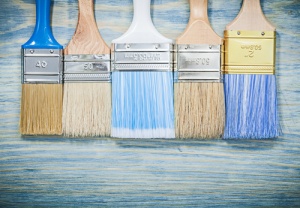
Despite your best planning, sometimes you find yourself stuck between a rock and a hard place, contemplating whether or not you can put off your painting project til the weather gets warmer. It’s definitely recommended to not paint the exterior of your home during the coldest months of the year, but if it’s inevitable, there are precautions you can take to make the best out of the situation.
The side effects and downsides
Waiting for the weather to warm up is a pain. Although we’ve had a warm winter so far, the weather is finally starting to cool down and things are beginning to freeze. Water based paints will freeze at 32 degrees. Painting in cold weather would classify anything less than 55 degrees. If you attempt a painting project outside in temperatures less than 55 degrees, here are a few of the issues you may encounter:
-Uneven coloration
-Water spotting, with latex paints
-Slow and inconsistent drying times
-Film cracking
Try to warm it up
So, you’ve decided to continue with your painting project mid-January, anyway? Try to set yourself up for success. We can’t guarantee that you’ll get good results, and if at all possible, you should try to wait for just a few months(the weather should start getting a bit warmer and more bearable in March).
The warmest part of the day is between 10am and 2pm, so try to paint during this window of time, so you can take advantage of as warm of a day as possible. You should also check the weather forecast and try to find the warmest day of the week, and plan to paint that day.
Check the temperature of the surface you’ll be painting. If it’s cold to the touch, you’re in trouble. Take a hair dryer to the area for just a moment before applying the paint. You’re not trying to cook the existing paint off, but paint goes on best at around 70-80 degrees.
Create a warm air bubble around the area you’ll be painting by using plastic sheets to close the area off. You can make a small frame to drape the plastic around the area that needs painted. Place a small space heater inside this bubble, and heat it up to around 70 degrees(you don’t want it to be too hot!). Paint inside this bubble, and then leave the bubble intact for a minimum of a few hours, maintaining that same temperature. Don’t leave the bubble unattended or overnight, as you could risk having a fire!
- When Do I Need to Replace My Rain Gutters? - May 20, 2024
- Getting Your Rain Gutters Ready For Spring - April 22, 2024
- Why James Hardie Siding Is Perfect For Your Home - March 26, 2024



